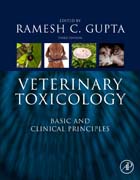
Veterinary Toxicology, Basic and Clinical Principles, Third Edition is a unique, single reference that teaches the basic principles of veterinary toxicology to any student at the DVM, MS or PhD level. While comparable texts are primarily directed on the field of human toxicology, this text thoroughly prepares toxicologists and students on the newest approaches for diagnosing chemical and plant poisoning cases in animals. Many chapters on topics not covered in any previous books are provided, such as target organ toxicity, radiation and radioactive materials, FDA regulatory issues, and ethics in veterinary toxicology. Completely revised and updated to include the most recent developments in the field, including new toxins, methods and regions, this book is an essential resource for advanced students and researchers in toxicology, practicing veterinary toxicologists, poison control centers, marine biologists, environmentalists and animal scientists. Provides a complete, up-to-date, integrated source of information on toxins and poisons relating to animalsCovers all important aspects of veterinary toxicology with completely updated and revised chaptersIncludes basic principles of a key toxicology concept, along with clinical applications and a list of major references for further reading INDICE: Section I: General 1. Concepts in veterinary toxicology 2. Toxicokinetics 3. Factors affecting chemical toxicity 4. Toxicological testing: in vivo and in vitro models 5. Epidemiology of animal poisonings in the United States 6. Epidemiology of animal poisonings in Europe 7. Epidemiology of animal poisonings in Asia 8. Chemicals of terrorism 9. Regulatory considerations in veterinary toxicology 10. Regulatory aspects for the drugs and chemicals used in food-producing animals in the European Union 11. Regulatory aspects for the drugs and chemicals used in Japan 12. Statistics in veterinary toxicology 13. Computational modeling in veterinary toxicology (New chapter) 14. Toxicology and the law Section II: Organ Toxicity 15. Nervous system toxicity 16. Respiratory toxicity 17. Cardiovascular toxicity 18. Liver toxicity 19. Renal toxicity 20. Reproductive toxicity and endocrine disruption 21. Placental toxicity 22. Dermal toxicity 23. Blood and bone marrow toxicity 24. Immunotoxicity Section III: Nanoparticles, Radiation and Carcinogens 25. Toxicity of nanomaterials 26. Ionizing radiation and radioactive materials in health and disease 27. Carcinogenesis: mechanisms and models Section IV: Drugs of Use and Abuse 28. Toxicity of over-the-counter drugs 29. Toxicity of drugs of abuse Section V: Metals and Micronutrients 30. Aluminum 31. Arsenic 32. Cadmium 33. Chromium, iodine and phosphorus 34. Copper 35. Fluoride 36. Iron 37. Lead 38. Manganese 39. Mercury 40. Molybdenum 41. Selenium 42. Sodium chloride (salt) 43. Sulfur 44. Zinc Section VI: Insecticides and Molluscicides 45. Organophosphates and carbamates 46. Organochlorines 47. Pyrethrins and pyrethroids 48. Neonicotinoids 49. Amitraz 50. Fipronil 51. Macrocyclic lactone endectocides 52. Rotenone 53. Metaldehyde Section VII: Herbicides and Fungicides 54. Toxicity of herbicides 55. Toxicity of fungicides Section VIII: Rodenticides and Avicides 56. Anticoagulant rodenticides 57. Non-anticoagulant rodenticides 58. Avitrol Section IX: Gases, Solvents and Other Industrial Toxicants 59. Toxic gases 60. Alcohols and glycols 61. Petroleum 62. Polychlorinated biphenyls, polybrominated biphenyls, polychlorinated dibenzo-p-dioxins, and polychlorinated dibenzofurans 63. Polycyclic aromatic hydrocarbons 64. Brominated flame retardants and perfluorinated chemicals Section X: Environmental Toxicology 65. Principles of ecotoxicology 66. Avian toxicology 67. Aquatic toxicology 68. Toxicology and diversity of marine toxins Section XI: Bacterial and Cyanobacterial Toxins 69. Botulinum neurotoxins 70. Enterotoxins 71. Cyanobacterial (blue-green algae) toxins Section XII: Poisonous and Venomous Organisms 72. Terrestrial zootoxins 73. Mare reproductive loss syndrome Section XIII: Estrogenic Toxicants 74. Chemical-induced estrogenicity 75. Phytoestrogens Section XIV: Poisonous Plants 76. Poisonous plants of the USA 77. Poisonous plants of Europe 78. Poisonous plants of Australia and New Zealand 79. Cyanogenic plants 80. Nitrate and nitrite accumulating plants 81. Toxicity of yew (Taxus spp.) alkaloids 82. Oxalate-containing plants 83. Mushroom toxins 84. Datura species and related plants 85. Cottonseed toxicity 86. Fescue toxicosis Section XV: Mycotoxins 87. Aflatoxins 88. Ergot 89. Fumonisins 90. Ochratoxins and citrinin 91. Slaframine 92. Tremorgenic mycotoxins 93. Trichothecenes 94. Zearalenone Section XVI: Feed and Water Contaminants 95. Melamine and cyanuric acid 96. Ionophores 97. Nonprotein nitrogen (urea) and hyperammonemia 98. Water quality and contaminants Section XVII: Diagnostic Toxicology 99. Basic concepts of analytical toxicology 100. Sample submission for toxicological analysis 101. Toxicoproteomics in diagnostic toxicology 102. Microscopic analysis of toxic substances in feeds and ingesta Section XVIII: Prevention and Treatment 103. Prevention and treatment of poisoning
- ISBN: 978-0-12-811410-0
- Editorial: Academic Press
- Encuadernacion: Cartoné
- Páginas: 1180
- Fecha Publicación: 01/02/2018
- Nº Volúmenes: 1
- Idioma: Inglés
